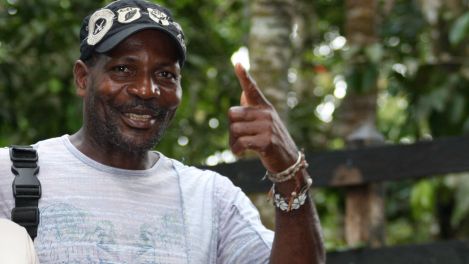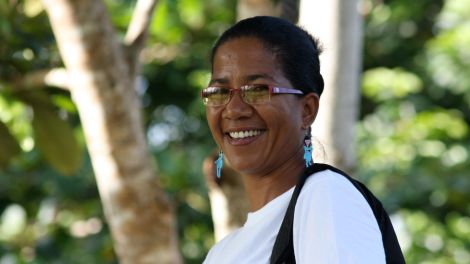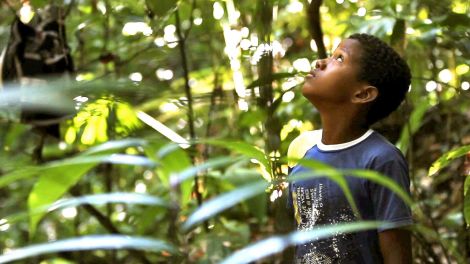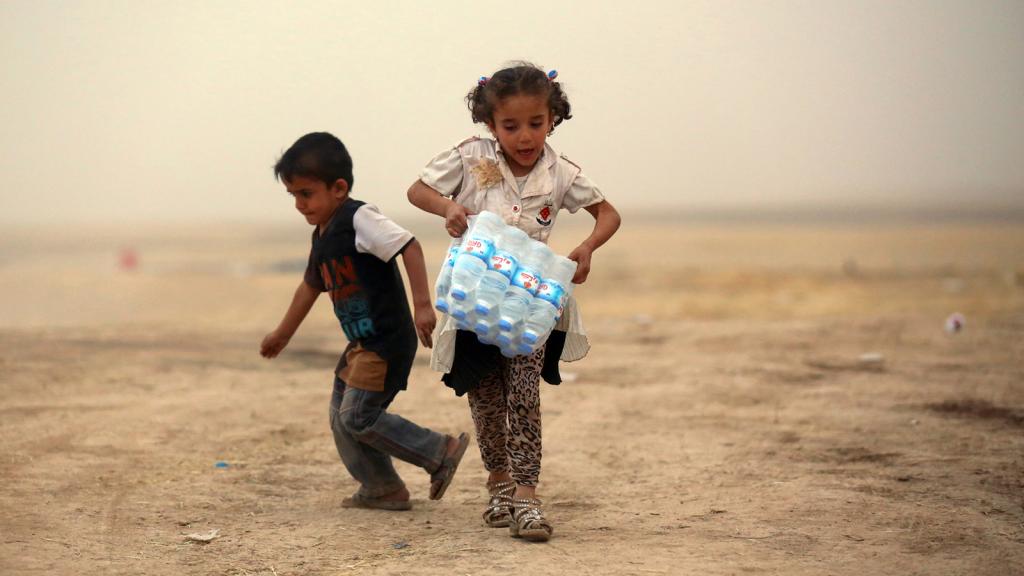On a stifling hot afternoon, five men make their way through the dense rainforest of northern Colombia. Frazier Guisao, a former logger, heads the single-file line, slicing through the thick undergrowth with a machete to carve out a narrow tunnel.
Guisao and his team wear T-shirts embossed with bright letters spelling out COCOMASUR, an abbreviation of the Spanish name of their small Afro-Colombian enclave, known as the Black Communities of the Tolo River and Southern Coast.
When the group pauses for a break at the base of a giant almendro tree, Guisao looks up to examine it. Trees in this region can reach as high as 10-story buildings. The trunk of this one would take 15 people hand-in-hand to surround. “This wood is worth around three million pesos in town,” he says. That’s about $1,500.
Guisao and his team are here to make sure that these trees are never cleared for profit, though.
Three years ago, the Tolo River community decided not to log its 32,000 acres of rainforest, and instead to protect it for its pristine habitat and the river that gives the community both its name and its only source of fresh water.
In addition to these obvious benefits, the forest offers another valuable service: The trees and soil are a safe depository of carbon. When rainforests are burned or cleared, carbon escapes into the air in the form of carbon dioxide, a gas that warms Earth’s climate.
Increasingly, companies and governments around the world are willing to pay communities like the Tolo River to preserve rainforests as a way of offsetting their own carbon emissions, and slowing climate change. In 2012, governments and corporations bought a half a billion dollars worth of carbon offset through a global, United Nations-lead initiative known as REDD — short for Reducing Emissions from Deforestation and Forest Degradation.
The program has drawn criticism for corruption, improper carbon accounting, and project developers taking advantage of illiterate indigenous peoples. Still, forest conservation through REDD can be part of the solution to both deforestation and climate change.
This is the story of one community that found a way to do it right.

AnthrotectTolo River community leader Aureliano Córdoba
Aureliano Córdoba is the Tolo River community leader. He is a quiet and charismatic man, devoted to the people who look up to him, and to the land that sustains them. Córdoba has a long history in this community. In the 1990s, he and hundreds of others had to flee to Panama after paramilitaries raided the village, forcing him to sell his land and killing his son.
Córdoba came back to the village in 2001, after the violence had subsided, and the Colombian government awarded the community title to the surrounding rainforest in 2005. But the threat to the Tolo River people wasn’t over. The community’s neighbors, rich and powerful cattle ranchers, were constantly encroaching on the land, clearing about 500 acres of forest each year to expand their pastures.
A few years after returning, Córdoba met Brodie Ferguson – a Stanford anthropologist who was studying this post-conflict region. With Ferguson’s help, the Tolo River people took three years to design and set up a REDD project, which would essentially pay the community to protect the carbon in its trees by making sure they were not cut.
The community then measured the wood density to determine how much carbon emissions each acre would emit if it was cleared. Workers estimated that by keeping the forest standing, the community could prevent the emission of up to 90,000 tons of carbon dioxide each year – equivalent to the pollution from 20,000 cars.
Last year, the Tolo River community sold 70,000 carbon offsets, each representing one ton of carbon left in standing trees, at about $9 apiece. About a half of the revenue was spent on repaying the initial investment to set up the project (studying the forest and paying auditors to calculate the exact amount of carbon stored there) and on finding buyers for the offsets. The other half pays for the ongoing expenses, such as the staff’s training and salaries and a communal fund for jointly decided projects and community emergencies.
Young Afro-Colombians in Peñaloza, the central village of the Tolo River community, have many ideas how to spend the community fund. They dream of bringing in a rural nurse and medical supplies, professional courses for adults, improvements in the village school, subsidized seeds for struggling farmers, and microfinancing for a local women’s food delivery service. Whatever project the money is spent on, it has to be approved by the whole community. No cash payments are distributed to the families.
Everildys Córdoba, project coordinator for the Tolo River community and Aureliano Córdoba’s niece, explains that after many years of violence, the Tolo River people feel empowered to determine their own direction of development. Affirming their ownership of the forest and ensuring its protection has taught them how to demand their rights.
“This is what our organization does. It gives power to the people, not cash,” she says. “Money wouldn’t make us better off. I wouldn’t work in it if we were distributing money instead of information.” She explains how tremendously empowering has it been for the community members to realize that they have rights – to their land, to education, to healthcare and so on.

AnthrotectEverildys Córdoba, REDD project leader
Not everyone in the region is happy with the community’s initiative. An attendant at the Builes cattle ranch, one of the largest bordering the Tolo River forest, sits in the shade of beautiful white mansion overlooking the 10,000-acre farm. She complains that over the past couple of years, the ranch has not been able to clear more forest for pasture and expand. “All of this land is now a reserve” she says, waving her hand toward the forested hills in the distance.
But even though deforestation does not take place anymore in the Tolo River community forest, there is no guarantee that the practice won’t “leak” into some other, less protected area. Even if the Builes ranch can’t expand, another ranch an hour north of it might pick up the slack at the expense of an unpatrolled forest. And even if all 200,000 square miles of rainforest in Colombia obtained special protection, an equal amount of Brazilian forest might get chopped down to meet the ever-increasing demand for beef, palm oil, and timber.
Exported deforestation is one of several critiques leveled at REDD by the program’s opponents. They are also concerned about the identity of the carbon credit buyers. For instance, one of the companies that purchased carbon credits from the Tolo River is the Colombian oil services firm Independence, which drills and manages oil wells for fossil fuel corporations such as Ecopetrol, Occidental, and Petrobras.
Two years ago, Independence decided to reduce its own carbon footprint to zero, says Gaelle Espinosa, the company’s environmental coordinator, from her 19th-floor office in downtown Bogota. (While it takes credit for diesel engines used in drilling and employee transportation, Independence attributes the emissions from burning all the petroleum it the pumps to its clients – the oil companies.) It has done this by switching to more fuel-efficient engines – and buying offsets for around 20,000 tons of carbon emissions each year from the Tolo River project.
“We are an oil services company yet we want to be carbon neutral – of course there is a contradiction,” says Espinosa, who used to work at World Wildlife Fund and considers herself an environmentalist. “But we as a single company cannot be responsible for everything in the industry or in the world. So I think we move with the market.”
Ferguson, the anthropologist, is aware of the potential drawbacks of selling carbon credits indiscriminately. He says the ideal buyer of carbon offsets is a company with a comprehensive strategy for reducing its impact. That includes energy efficiency, recycled materials, and control over the supply chain. Carbon offsets should come after, not instead of, reducing emissions, he says.
“I don’t think anybody likes the idea of a coal company saying ‘OK, we are going to continue producing coal and we are going to buy some carbon credits half-way around the world just to offset that.’” says Ferguson. “It violates the whole spirit of what you are trying to do.”

Anthrotect
In recent years, companies such as Microsoft, Disney, and Puma have invested millions of dollars into REDD projects in Kenya, Peru, and Madagascar as part of their own sustainability plans. Carbon credits are available even for individuals who want to offset personal emissions from flying or driving.
As the Tolo story shows, small-scale REDD projects are not a silver-bullet solution to either deforestation or climate change. But they are a start. If scaled up sufficiently, these projects provide hope for not only the environment and climate, but also for human rights and development.
The revenue from carbon offsets projects will never compare to the profitability of alternatives such as clearing the forest for cattle ranches, cocoa plantations, or gold mines. But given the added benefits of community empowerment, fresh water, and protected natural habitat, the choice starts to make sense.
“Forests are so much more than carbon credits,” says Ferguson.
“We are really happy here as a community,” says Eusebio Guisao, the former logger’s brother. “If we could show this to others, they would understand that it’s not money that resolves problems. It’s self-determination.”




